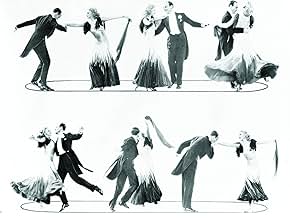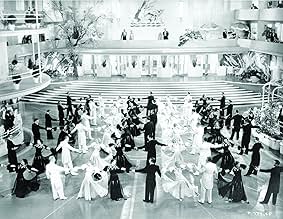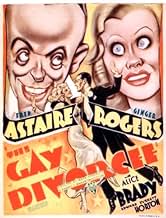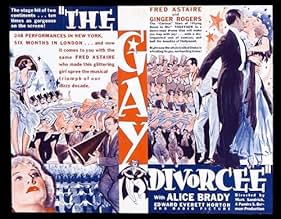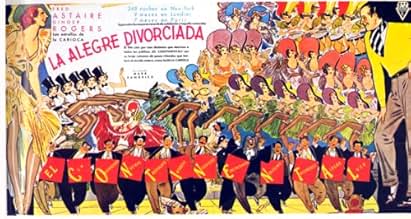IMDb-BEWERTUNG
7,3/10
9130
IHRE BEWERTUNG
Füge eine Handlung in deiner Sprache hinzuA woman thinks a flirting man is the co-respondent her lawyer has hired to expedite her divorce.A woman thinks a flirting man is the co-respondent her lawyer has hired to expedite her divorce.A woman thinks a flirting man is the co-respondent her lawyer has hired to expedite her divorce.
- 1 Oscar gewonnen
- 4 Gewinne & 5 Nominierungen insgesamt
Norman Ainsley
- Undetermined Role
- (Nicht genannt)
Jimmy Aubrey
- Undetermined Role
- (Nicht genannt)
Finis Barton
- Undetermined Role
- (Nicht genannt)
Eleanor Bayley
- Dancer
- (Nicht genannt)
De Don Blunier
- Chorus Girl
- (Nicht genannt)
Pokey Champion
- Dancer
- (Nicht genannt)
Jack Chefe
- Night Club Patron
- (Nicht genannt)
Empfohlene Bewertungen
Following an apparently accidental teaming in 1933's Flying Down to Rio (a fun Dolores Del Rio vehicle), Fred and Ginger got their first starring feature a year later. It was based on J. Hartley Manners' play 'The Gay Divorce'. The Hays Office insisted on shoving an 'e' on the end, for how could a divorce be so trifling as to be gay? Some UK prints still run with the original title. RKO assembled a sparkling ensemble cast of top-flight farceurs, bringing together (in ascending order of sublimity) Eric Blore, Edward Everett Horton and Erik Rhodes ("Are you a union man?"). Mark Sandrich directs the thing with a maximum of fuss and style. Hermes Pan helped Fred choreograph the numbers.
The plot is suitably - and delightfully - trivial. Musical star Guy Holden (Fred) happens upon a girl (Ginger), falls desperately in love with her, then spends the rest of the picture trying to free himself from marvellously silly plot threads and Everett Horton's exquisite quadruple-takes.
Keeping just one song from Cole Porter's original score, the timeless 'Night and Day', and adding only four others, The Gay Divorcée is more a comedy with songs than it is a musical comedy. But what comedy - and what songs! 'Looking For a Needle in a Haystack' is a masterpiece of economy: Fred a whirlwind of frustrated, lovestruck energy as he spins around his hotel room lamenting his missing love in peerless style. "Men don't pine," he memorably concludes, "Women pine. Men ... suffer." Everett Horton's rare excursion into song-and-dance territory is a breath of hysterical, liberating ludicrousness, as he knocks knees with a young Betty Grable. 'Don't Let It Bother You', performed by a chorus of dancing girls (and dolls), then spectacularly reprised by a tapping Astaire, is another treat. 'The Continental', the film's vast production number is peculiarly edited but sporadically fine and offers a fitting climax.
It's exceptional fluff, the sort of heady, heightened escapism that you don't come close to very often. An extravagantly mounted, joyous comedy played to perfection by two stars at their irresistible peak. Unmissable.
The plot is suitably - and delightfully - trivial. Musical star Guy Holden (Fred) happens upon a girl (Ginger), falls desperately in love with her, then spends the rest of the picture trying to free himself from marvellously silly plot threads and Everett Horton's exquisite quadruple-takes.
Keeping just one song from Cole Porter's original score, the timeless 'Night and Day', and adding only four others, The Gay Divorcée is more a comedy with songs than it is a musical comedy. But what comedy - and what songs! 'Looking For a Needle in a Haystack' is a masterpiece of economy: Fred a whirlwind of frustrated, lovestruck energy as he spins around his hotel room lamenting his missing love in peerless style. "Men don't pine," he memorably concludes, "Women pine. Men ... suffer." Everett Horton's rare excursion into song-and-dance territory is a breath of hysterical, liberating ludicrousness, as he knocks knees with a young Betty Grable. 'Don't Let It Bother You', performed by a chorus of dancing girls (and dolls), then spectacularly reprised by a tapping Astaire, is another treat. 'The Continental', the film's vast production number is peculiarly edited but sporadically fine and offers a fitting climax.
It's exceptional fluff, the sort of heady, heightened escapism that you don't come close to very often. An extravagantly mounted, joyous comedy played to perfection by two stars at their irresistible peak. Unmissable.
Looking at THE GAY DIVORCEE through the lens of 85 years, I can see flaws with it. The big dance number goes on too long, and the comedy writing isn't sharp enough. Still, this was the first star pairing of Fred Astaire and Ginger Rogers, and it's amazing how much they got right, right off the bat. There's the basic structure of Astaire courting Miss Rogers through a set of dances, while in between there are jokes and pulled faces and Edward Everett Horton doing several hundred double takes per minute as everyone's straight man.
It's based on Astaire's stage success The Gay Divorce. The name change was the result of the Breen office meddling. It's more a variation on the Princess Theater musical comedies of the 1920s, and the camerawork, although seemingly startling and original under the direction of David Abel, is more an outgrowth of German Expressionist camerawork, and bits and bobs from the best of contemporary British musicals. Add in Astaire's insistence on being seen full length while dancing -- which sounds obvious now, although not at the time -- and the formula required only a bit of refinement to produce a series of masterpieces.
You may notice Betty Grable at the bottom of the title card. She's the platinum blonde who makes love to Horton in the "Let's Knock Knees" number. She had been kicking around Hollywood since 1929, sometimes with a credit, sometimes, like her previous movie, without. She would never go uncredited again.
It's based on Astaire's stage success The Gay Divorce. The name change was the result of the Breen office meddling. It's more a variation on the Princess Theater musical comedies of the 1920s, and the camerawork, although seemingly startling and original under the direction of David Abel, is more an outgrowth of German Expressionist camerawork, and bits and bobs from the best of contemporary British musicals. Add in Astaire's insistence on being seen full length while dancing -- which sounds obvious now, although not at the time -- and the formula required only a bit of refinement to produce a series of masterpieces.
You may notice Betty Grable at the bottom of the title card. She's the platinum blonde who makes love to Horton in the "Let's Knock Knees" number. She had been kicking around Hollywood since 1929, sometimes with a credit, sometimes, like her previous movie, without. She would never go uncredited again.
This was the first RKO film that Fred Astaire and Ginger Rogers did in which they are the central characters. In the first two they play wise cracking supporting roles, and if you don't know what is going on you might say "Hey, why don't Gene Raymond and Delores Del Rio get out of the way and let Fred and Ginger do their stuff?". It was because Fred and Ginger as a team were a bit of a surprise to RKO.
At any rate, like I said, this seems like a warm up for "Top Hat" a year later, but it is still a great film. But the two share a few pieces of the basic formula. Fred and Ginger meet in such a way that annoys Ginger and gets Fred interested, and once Ginger begins to return Fred's affection a complete misunderstanding that Fred knows nothing about causes Ginger to lose all interest in a now confused Fred. Edward Everett Horton plays Fred's loyal but befuddled friend, and Eric Blore, who at first seems like a minor character who is in the film mainly to flummox Horton's character plays a much bigger part in the plot than you would ever imagine. Erik Rhodes plays an Italian who never really has a chance as third vertex in a triangle in which the other two are Fred and Ginger, but he plays that part with great comic style.
A couple of mistakes fixed by "Top Hat" that this one has - First, Fred Astaire is given no solo dance numbers. Second, too much Alice Brady can get annoying. In "Top Hat" her part is taken by Helen Broderick who had a great dry comic wit.
Still, highly recommended.
At any rate, like I said, this seems like a warm up for "Top Hat" a year later, but it is still a great film. But the two share a few pieces of the basic formula. Fred and Ginger meet in such a way that annoys Ginger and gets Fred interested, and once Ginger begins to return Fred's affection a complete misunderstanding that Fred knows nothing about causes Ginger to lose all interest in a now confused Fred. Edward Everett Horton plays Fred's loyal but befuddled friend, and Eric Blore, who at first seems like a minor character who is in the film mainly to flummox Horton's character plays a much bigger part in the plot than you would ever imagine. Erik Rhodes plays an Italian who never really has a chance as third vertex in a triangle in which the other two are Fred and Ginger, but he plays that part with great comic style.
A couple of mistakes fixed by "Top Hat" that this one has - First, Fred Astaire is given no solo dance numbers. Second, too much Alice Brady can get annoying. In "Top Hat" her part is taken by Helen Broderick who had a great dry comic wit.
Still, highly recommended.
Quoting the Eric Blore/Alice Brady interchange in the restaurant, this movie is indeed whimsical (or "whumsical") and beautiful to boot. There probably has never been a more perfect dance than "Night and Day"....or a more beautiful song to dance to. That is the highlight of this film, although the rest of it is well worth seeing. Erik Rhodes is absolutely hilarious as the paid correspondent and the humor is not dated which is unusual in a film of this age. The "Chance is a fool's name for fate" routine is priceless. Edward Everett Horton again proves that he is the originator of the befuddled sidekick without being irritating and his little "dance" with a very young Betty Grable is such fun The art deco sets and great 30's clothes are wonderful and it makes you wish for a time when everybody wore evening dress and danced at the drop of a hat. Don't miss it...this is one of the highlight Astaire/Rogers efforts.
The Gay Divorcée is the answer to the trivia question of which of Fred Astaire's and Ginger Rogers's is one that Fred Astaire had previously done on Broadway. When Astaire did it on Broadway, the Cole Porter musical had been entitled The Gay Divorce. But that extra 'e' was added on lest anyone get the idea that divorce itself was something frivolous. Imagine anticipating Britney Spears by about 70 years.
Actually Fred had also done Funny Face and The Bandwagon on stage as well. But on stage The Bandwagon was a revue and Funny Face had an entirely different plot than the musical made by Astaire in the Fifties. Only in The Gay Divorcée was he asked to repeat a stage role.
The basic plot is still the same, the usual Astaire-Rogers case of mistaken identity. Ginger is the budding divorcée going to London to get a divorce as Aunt Alice Brady hired a professional co-respondent. Ginger mistakes Fred for that co-respondent and it takes a while for Fred to warm her up.
Fred's an American musical comedy star visiting London with his manager Edward Everett Horton who also happens to know Brady. This gives the excuse for the musical numbers.
Cole Porter's score was cut completely from the screen other than the immortal Night and Day. In it's place came four songs, three written by Harry Revel&Mack Gordon and one written by Con Conrad&Herb Magdison. Fred and Ginger dance divinely to Night and Day.
Fred does a solo dance to A Needle in a Haystack and Don't Let It Bother You. Betty Grable got her first notice from the movie going public, singing and dancing in Let's Knock Knees all of which were contributed by Revel&Gordon.
But it was The Continental number by Con Conrad and Herbert Magdison that got the first Academy Award ever given out for Best Original Song in a motion picture. It's what The Gay Divorcée is remembered for today. It's a rather long, between ten and fifteen minutes of screen time, but as magical as ever
The Gay Divorce ran for 248 performances on Broadway during the 1932- 1933 season. Sacrificed for romance are Porter's witty lyrics in the rest of the score containing their usual commentary on the social scene. Of all the American musical giants of the era, I would say that Cole Porter wins hands down as the man that Hollywood butchered the most in bringing his work to the screen. Even before The Code was in place, it seemed that the powers that be deemed that his work was way too sophisticated and naughty to be seen and heard as is.
Still with the film being frothy romance instead of social commentary, The Gay Divorcée is still great entertainment. Also repeating their roles from Broadway are supercilious waiter Eric Blore and the real co-respondent Tonetti who prefers spaghetti, Erik Rhodes.
Wit for romance, you decide if it was a fair exchange.
Actually Fred had also done Funny Face and The Bandwagon on stage as well. But on stage The Bandwagon was a revue and Funny Face had an entirely different plot than the musical made by Astaire in the Fifties. Only in The Gay Divorcée was he asked to repeat a stage role.
The basic plot is still the same, the usual Astaire-Rogers case of mistaken identity. Ginger is the budding divorcée going to London to get a divorce as Aunt Alice Brady hired a professional co-respondent. Ginger mistakes Fred for that co-respondent and it takes a while for Fred to warm her up.
Fred's an American musical comedy star visiting London with his manager Edward Everett Horton who also happens to know Brady. This gives the excuse for the musical numbers.
Cole Porter's score was cut completely from the screen other than the immortal Night and Day. In it's place came four songs, three written by Harry Revel&Mack Gordon and one written by Con Conrad&Herb Magdison. Fred and Ginger dance divinely to Night and Day.
Fred does a solo dance to A Needle in a Haystack and Don't Let It Bother You. Betty Grable got her first notice from the movie going public, singing and dancing in Let's Knock Knees all of which were contributed by Revel&Gordon.
But it was The Continental number by Con Conrad and Herbert Magdison that got the first Academy Award ever given out for Best Original Song in a motion picture. It's what The Gay Divorcée is remembered for today. It's a rather long, between ten and fifteen minutes of screen time, but as magical as ever
The Gay Divorce ran for 248 performances on Broadway during the 1932- 1933 season. Sacrificed for romance are Porter's witty lyrics in the rest of the score containing their usual commentary on the social scene. Of all the American musical giants of the era, I would say that Cole Porter wins hands down as the man that Hollywood butchered the most in bringing his work to the screen. Even before The Code was in place, it seemed that the powers that be deemed that his work was way too sophisticated and naughty to be seen and heard as is.
Still with the film being frothy romance instead of social commentary, The Gay Divorcée is still great entertainment. Also repeating their roles from Broadway are supercilious waiter Eric Blore and the real co-respondent Tonetti who prefers spaghetti, Erik Rhodes.
Wit for romance, you decide if it was a fair exchange.
Wusstest du schon
- WissenswertesThe musical number "The Continental" lasts 17 1/2 minutes, the longest number ever in a musical until Gene Kelly's 18 1/2-minute ballet at the end of Ein Amerikaner in Paris (1951) 17 years later. It is also the longest musical number in all of Fred Astaire and Ginger Rogers' films together.
- PatzerDuring the car chase, Guy makes a quick turn on a dirt road, and a sound effect of squealing tires is heard. Tires do not make a squealing noise on dirt.
- Zitate
Tonetti: [unable to remember his passphrase "Chance is a fool's name for fate," Tonettie repeatedly muffs it] Chance is the foolish name for fate. / Give me a name for chance and I am a fool. / Fate is a foolish thing to take chances with. / I am a fate to take foolish chances with. / Chances are that fate is foolish. / Fate is the foolish thing. Take a chance.
- Alternative VersionenIn the version of the movie released in Brazil in the 1930s, the Brazilian actor Raul Roulien sang in the musical number "The Continental".
- VerbindungenEdited into Joan of Paris (1942)
- SoundtracksDon't Let It Bother You
(1934)
Music and Lyrics by Mack Gordon and Harry Revel
Dance performed by Fred Astaire
Top-Auswahl
Melde dich zum Bewerten an und greife auf die Watchlist für personalisierte Empfehlungen zu.
- How long is The Gay Divorcee?Powered by Alexa
Details
- Erscheinungsdatum
- Herkunftsland
- Offizieller Standort
- Sprachen
- Auch bekannt als
- La alegre divorciada
- Drehorte
- Santa Monica, Kalifornien, USA(Exterior)
- Produktionsfirma
- Weitere beteiligte Unternehmen bei IMDbPro anzeigen
Box Office
- Budget
- 520.000 $ (geschätzt)
- Weltweiter Bruttoertrag
- 6.879 $
- Laufzeit
- 1 Std. 47 Min.(107 min)
- Farbe
- Seitenverhältnis
- 1.37 : 1
Zu dieser Seite beitragen
Bearbeitung vorschlagen oder fehlenden Inhalt hinzufügen



